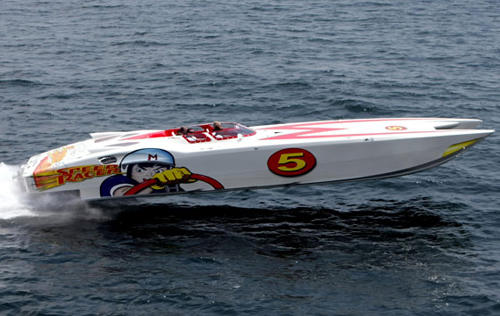Commentary: Building on a Bridge Blunder
Speed Racer in flight. Photo courtesy/copyright Tim Sharkeyl
I am not the world’s best high-performance powerboat driver. Fact is, I’m not even close. I am just competent behind the wheel. So I embrace that honest self-assessment and combine it with caution, which probably makes me better than average. But that’s it.
That I describe myself as just “better than average” when it comes driving go-fast boats might surprise or even shock you. After all, I wrote for Powerboat magazine for 17 years and rode in hundreds of boats with the likes of Bob Teague, Steve David and John Tomlinson.
But that’s akin to riding shotgun in a sports car with the likes of Matt Kenseth—enlightening, educational and sometimes scary as hell, yet far from hands-on experience and instruction. I learned everything I could and grabbed seat-time whenever I had the chance. But that’s it.
Last month during the Miami Boat Show Poker Run, I was reminded not just of my experience and ability as a driver but that the learning process never stops. I was driving the well-known 44-foot-long MTI catamaran Speed Racer—the fourth time I’ve had the privilege—with the boat’s owner Bob Christie on the throttles back to Coconut Grove from Islamorada in the Florida Keys. In the cockpit behind us were Bob’s wife, Madeline, and my good friends Joe Nasso and Dr. Gabe Jasper.
We were following our Intracoastal Waterway “breadcrumb trail” back to Grove Harbour Marina, where we had launched the incredible cat a few days earlier, on the boat’s large-screen GPS. Save for the occasional brief rain shower and low-lying morning mist, visibility was good. I kept my eyes on the waterway ahead and regularly glanced at the GPS to make sure we were on course.
At some point, however, I became more interested in reading the GPS than the water and channel markers ahead. Less than a mile away, I could see a bridge. On the GPS screen in front of me, I could see that the course setup for the bridge was a sweeping left turn followed by a hard, 90-degree right.
The left turn went well. The right turn did not. Focusing too much on the GPS, rather than the channel markers and the water ahead, put me late into the turn and had Christie yelling, “Right, right, right!” What’s more, I didn’t immediately pick up the correct channel under the bridge, which made me even later into the turn.
The story ends without drama—Christie had us running slowly enough for me to correct and get back on course before we reached the bridge—but not without a lesson: Getting fixated on your GPS is a huge mistake. GPS can help you find your way home, but it is never a substitute for heads-up driving and navigation.
I’ve known that for years, but the lesson was rammed home to me that morning in front of four dear friends who trusted me to safely get them home. Next to my anger at myself, the embarrassment I felt was nothing.
As it should have been, because on that day I was neither competent nor better than average. I was lucky—both in the moment and in a lesson I will never have to learn again.


